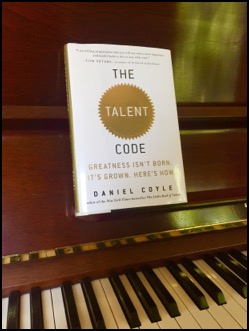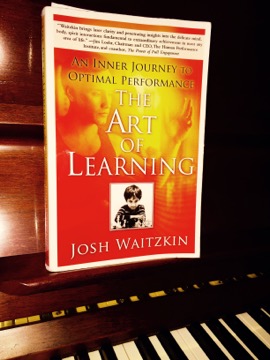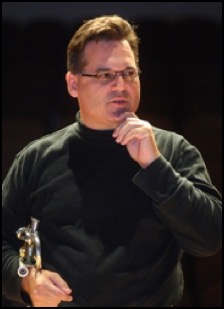practice
The Talent Code
12/09/15 Filed in: Review

Coyle identifies three key elements to learning:
- Chunk it
- Repeat it
- Feel it (concentrate)
The first technique described is 'chunking'--yes, that is the actual name coined by psychologists--and it is simply the idea of taking a small piece of a larger task, mastering that piece, then moving on to the next part of the task.
The brain learns through repetition, with each repetition adding a layer of myelin to a set of synapses, thereby making them more efficient the next time that activityis repeated. The myelin will layer on undesireable activity just as easily as a preferred activity, so it is important to be accurate. The sweet spot is 'deep practice,' where one is struggling at the edge of one's abilities, thus fully engaging one's concentration; in these circumstances, synapses fire more quickly, creating more myelin.
The third technique, concentration, is perhaps the most important--it is the gateway to deep practice. If you simply 'play though' your piece, you are training yourself not to pay attention. Remember, deep concertration layers on more myelin.
The Talent Code is written to be applicable to any field, and yet Coyle draws enough examples from music that one can come away with specific practice techniques. Coyle went to the string camp Meadowmount and describes a few chunking techniques used there:
- Changing running eighth notes into a dotted rhythm--micro chunking--forcing your brain to master two notes above tempo, then allowing a small 'rest' before tackling the next two notes.
- Cutting a score into one-stave strips, then randomly pulling those strips out of an envelope forcing a more macro chunking. (In this instance setting a limited, specific, immediately attainable goal, thereby forcing concentration on a limited task, may be as important as the 'chunking.')
Coyle goes on to examine the techniques of great coaches and teachers and finds four fundamental elements:
- The coach/teacher needs a thorough understanding of the material (what Coyle calls the "matrix").
- Perceptiveness: the teacher must not simply observe errors, but understand their causes so they may be pulled put by the roots (hence the need for the matrix of knowledge).
- The teacher must provide hyper-direct and immediate feed back that is specific, praises the good, and identifies the bad.
- The teacher must exhibit a theatrical honesty: criticism must be honest, though not necessarily fair. They must praise their worst student for an acheivement that they would criticize in their best, meaning, and push each individual to their next step.
Finally Coyle tells us to explain the brain to our students:
"Tell [your students] how myelin works. Carol Dweck split seven hundred low-achieving middle schoolers into two groups. The first were given an eight-week workshop of study skills; the second were given the identical workshop along with something extra: a fifty-minute session that described how the brain grows when it is challenged. Within a semester the second group had significantly improved their grades and study habits. The experimenters didn't tell the teachers which group the kids were in, but the teachers could tell anyway. " --page 217
The Art of Learning
27/06/15 Filed in: Review

His book, The Art of Learning, offers solid advice on the fundamentals of efficient learning illustrated with entertaining personal anecdotes. The strength of the book is this combination of advice and illustration. I am sure that while living through the events depicted the path was not always as clear as he makes it sound, yet he has laid out an approach one can imagine following.
The book presents an approach that could be applied to any field where excellence is a goal. This is, of course, why a book drawing examples from Tai Chi Chuan and chess is of value to a musician. One can't help but wish for a companion work book that applied these techniques in a concrete manner, however, there are books that can fill the gap, and, for trumpeters, I recommend diving into Daily Fundamentals for the Trumpet by Michael Sachs with the Waitzkin approach in mind.
Usually a book of fundamentals is a collection of exercises that expose basic techniques to scrutiny. There is some of that here, but Mr. Sachs focuses on extracting fundamental exercises from whatever music you are studying. As an example. he delves deeply into the opening of the Trumpet Concerto by Joseph Haydn exposing the fundamental structure of the passage in a manner one could imagine Mr. Waitzkin using.
From The Art of Learning
"The key to pursuing excellence is to embrace an organic, long-term learning process, and not to live in a state of static, safe mediocrity." --page 33
"While I learned with open pores--no ego in the way--it seemed that many other students were frozen in place, repeating their errors over and over, unable to improve because of a fear of releasing old habits." --page 107-108.
"I have long believed that if a student of virtually any discipline could avoid ever repeating the same mistake twice--both technical and psychological--he or she would skyrocket to the top of their field." --page 108
". . .my vision of the road to mastery--you start with the fundamentals, get a solid foundation fueled by understanding the principles of your discipline, then you expand and refine your repertoire, guided by your individual predispositions, while keeping in touch, however abstractly, with what you feel to be the essential core of the art. What results is a deeply internalized, interconnected knowledge that expands from a central personal locus point." --page 138-139
"I started practicing. First I worked on each step slowly, over and over, refining my timing and precision. Then I put the whole thing together, repeating the movements hundreds, eventually thousands of times." --page 145
"Too many of us live without fully engaging our minds, waiting for that moment when our real lives begin. Years pass in boredom, but that is okay because when our true love comes around , or we discover our real calling, we will begin. Of course the sad truth is that if we are not present to the moment, our true love could come and go and we wouldn't even notice." --page 187
Fast practice
29/12/13 Filed in: Practice techniques
Jason Sulliman has posted a great video on fast practice. Rather than starting slowly and clicking up the metronome, fast practice involves starting at tempo but with only a small portion of the passage, gradually adding notes. My favorite method is to start at the end of a passage and to keep adding beats to the front of the lick.
Check out his video on Youtube:
Check out his video on Youtube:
